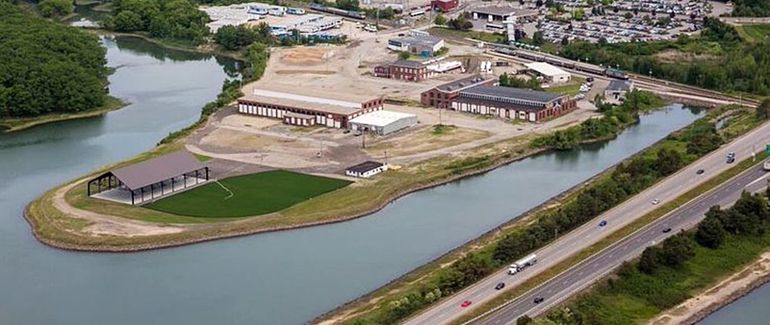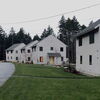Processing Your Payment
Please do not leave this page until complete. This can take a few moments.
- News
-
Editions
View Digital Editions
Biweekly Issues
- December 1, 2025
- Nov. 17, 2025
- November 03, 2025
- October 20, 2025
- October 6, 2025
- September 22, 2025
- + More
Special Editions
- Lists
- Viewpoints
-
Our Events
Event Info
Award Honorees
- Calendar
- Biz Marketplace
14 Maine sites to share $6 million in brownfield money
 Courtesy / Maine Preservation
Children's Museum and Theatre of Maine plans a 30,000 building on 1.12 acres it bought last year on Thompson's Point, in Portland, but the site first will be cleaned up with help from an EPA brownfields grant.
Courtesy / Maine Preservation
Children's Museum and Theatre of Maine plans a 30,000 building on 1.12 acres it bought last year on Thompson's Point, in Portland, but the site first will be cleaned up with help from an EPA brownfields grant.
Polluted sites in 12 Maine communities will benefit from 14 grants totaling $6 million from the Environmental Protection Agency, the federal agency announced Wednesday.
Both governmental and nonprofit grantees in Portland, South Portland, Lewiston, Sanford, Lincoln, Belfast, Biddeford, Old Town and Washington County will use the money to assess and clean up former industrial and commercial property. Much of the money is going to under-served and economically disadvantaged communities, the EPA said in a news release.
The Maine sites are among 151 grants awarded nationwide totaling $64.6 million.
Maine grantees are:
- Belfast, $300,000 for community-wide site assessment;
- Children’s Museum & Theater of Maine, in Portland, a $500,000 cleanup grant;
- Lewiston, a $500,000 cleanup grant;
- Lincoln will get two grants, $350,000 for assessment at the Lincoln Pulp & Paper site and $300,000 for community-wide assessment;
- Maine Port Authority, in Portland, a $500,000 cleanup grant;
- Marble Block Redevelopment Corp., in Biddeford, a $500,000 cleanup grant;
- Old Town, a $300,000 assessment grant;
- Portland Housing Authority, a $500,000 cleanup grant;
- Sanford, a $800,000 multi-purpose grant;
- South Portland Housing Development Corp., a $500,000 cleanup grant;
- South Portland, with a $300,000 assessment grant;
- Washington County Council of Governments, a $300,000 assessment grant for Eastport, Machias, Lubec and Sipayik.
- Waterfall Arts, in Belfast, a $350,000 cleanup grant.
The grants will help "communities in need transform contaminated sites into community assets that not only create jobs and jump start economic development, but also improve public health and the environment,” said EPA Administrator Andrew Wheeler in the release. “We are targeting these funds to areas that need them the most."
Wheeler said about 40% percent of the selected recipients are receiving brownfields grants for the first time. "Which means we are reaching areas that may previously been neglected, and 108 of the selected communities have identified sites or targeted areas for redevelopment that fall within Opportunity Zones," he said.
Much of the funding will be used to assess underused and possibly contaminated property that is being considered for redevelopment, the EPA said.
Economic revitalization benefits
Maine DEP Commissioner Jerry Reid said, “Many Maine towns are working to reinvent themselves by attracting clean, modern industries after local mills closed. Sanford is a perfect example. EPA’s Brownfields Initiative will promote the clean-up and redevelopment of projects like Sanford’s Mill District and complement other similar revitalization projects across the state.”
Across the six New England states this year, EPA is awarding a total of $11.6 million to more than 30 communities, said Deb Szaro, EPA New England acting regional administrator.
"Brownfields funding jumpstarts environmental cleanup at contaminated properties, allowing them to be re-developed to benefit the community and its residents," she said.
Grants awarded by EPA’s Brownfield Program provide communities across the country with an opportunity to transform contaminated sites into community assets that attract jobs and achieve broader economic development outcomes, while taking advantage of existing infrastructure, the EPA said.
A study of 48 brownfields sites found that an estimated $29 million to $97 million in additional local tax revenue was generated in a single year after cleanup, the EPA said. "This is two to seven times more than the $12.4 million EPA contributed to the cleanup of these sites," according to the release.
Another study found that property values of homes near revitalized brownfields sites increased between 5 and 15% following cleanup, according to the EPA.
More about the grant recipients
Belfast: The city plans to use $300,000 in assessment money to conduct nine environmental site assessments, and develop four cleanup plans.
Children’s Museum and Theatre of Maine: The $500,000 for cleanup of hazardous substances will be used to clean up the Thompson’s Point site in Portland, a 1.12-acre parcel that was developed as a railroad yard for the Maine Central Railroad in the late 1800s. Railroad use continued through the 1930s, and by the 1940s other industry, including an ordnance plant, had moved into the adjoining buildings. Between the 1960s through the 1980s, the tracks were removed from the site and a variety of industrial and commercial business occupied the adjoining buildings. The site is contaminated with polycyclic aromatic hydrocarbons, PCBs, arsenic and metals with limited co-mingled residual petroleum contamination.
Lewiston: The city will use $500,000 in cleanup money at the Bates Weave Shed (Mill 5) site, 15 Canal St. The site was first developed as a planing mill and lumber yard in 1856, housed a weave shed from 1914 to 2000, and has been vacant since 2000. The site is contaminated with inorganic contaminants, metals and PCBs.
Lincoln: The town's total $650,000 in two grants will assess up to 12 sites; site-specific grant money will be used to conduct environmental site assessment, and plan for reuse and cleanup of the Lincoln Paper and Tissue mill site at 50 Katahdin Ave. Past uses of the site include a saw mill, a shingle mill and a paper and pulp mill. The site closed in 2014 after a boiler explosion caused catastrophic damage. Both types of grant funds also will be used to expand an existing inventory of sites and support community involvement activities.
Maine Port Authority: The $500,000 grant will be used to clean up hazardous substances at the Portland International Marine Terminal Cold Storage Site, 40 West Commercial St., in Portland. The 21-acre site operated as a manufactured gas plant until it was decommissioned in 1965. Most recently, the site was used for a natural gas/propane distribution facility until 2016, and is currently vacant. The site is contaminated with coal ash, polycyclic aromatic hydrocarbons, metals and volatile and semivolatile organic compounds.
Marble Block Redevelopment Corporation: The $500,000 grant will be used to clean up the WestPoint Stevens Mill Boiler House, 2 Main St., in Biddeford. The site formerly was part of a large mill complex that operated from the late 19th century until 2009. The buildings on the site are contaminated with inorganic contaminants, metals, PCBs, and mercury. The subsurface soils at the site are contaminated with co-mingled polycyclic aromatic hydrocarbons, arsenic, metals and petroleum.
Old Town: The city will use $300,000 for 15 site assessments, and to develop seven cleanup plans. Grant money also will be used to assemble a brownfield advisory committee and hold public meetings. The target areas for the grant include Main Street and Stillwater Avenue, which served industrial mills built along the Stillwater and Penobscot rivers.
Portland Housing Authority: The $500,000 hazardous substances cleanup grant will be used for two parcels at the Front Street Redevelopment site, 37 and 63 Front St. Before 1956, the site was undeveloped tidal flats that were filled in and later developed in 1971 as an apartment complex. The site is contaminated with metals, inorganic contaminants and PCBs. Grant money also will be used to conduct community outreach, public meetings.
Sanford: Uses for the $800,000 grant include 11 environmental site assessments in the Sanford Energy Redevelopment Corridor and clean up the 17-acre former CGA Circuit Board site, which is targeted for solar and recreational development. Money also will be used to develop plans for market analysis, development and site reuse and to conduct community involvement activities.
South Portland Housing Development Corp.: The $500,000 will be used to clean up hazardous substances at the Thornton Heights Commons site, 611 Main St., a 1.81-acre site that was first developed as a church and residences in the early 1940s and operated as a religious institution and school until 2013. It has been vacant since then. It is contaminated with hazardous building materials including metals, inorganic contaminants and PCBs.
South Portland: The city will use $300,000 for community-wide assessment work, including 15 environmental site assessments, and prepare eight cleanup plans. Grant money also will be used to assemble a brownfield advisory committee and hold public meetings. The target areas for this grant include the waterfront neighborhoods of Knightville, Ferry Village, Pleasantdale and Ligonia.
Washington County Council of Governments, Machias, Lubec, Eastport, Sipayik: The $300,000 will be used for 16 site assessments, as well as to prepare a cleanup and redevelopment plan and conduct community involvement activities in Machias, Lubec, Eastport and Sipayik, adjoining Passamaquoddy tribal land.
Waterfall Arts: Waterfall Arts in Belfast will use $350,000 to clean up hazardous substances at its building at 256 High St. The building, dating from 1935, is contaminated with metals, inorganic contaminants, PCBs and mercury.
Mainebiz web partners

The Giving Guide
The Giving Guide helps nonprofits have the opportunity to showcase and differentiate their organizations so that businesses better understand how they can contribute to a nonprofit’s mission and work.
Learn More
Work for ME
Work for ME is a workforce development tool to help Maine’s employers target Maine’s emerging workforce. Work for ME highlights each industry, its impact on Maine’s economy, the jobs available to entry-level workers, the training and education needed to get a career started.
Learn More
Groundbreaking Maine
Whether you’re a developer, financer, architect, or industry enthusiast, Groundbreaking Maine is crafted to be your go-to source for valuable insights in Maine’s real estate and construction community.
Learn more-
The Giving Guide
The Giving Guide helps nonprofits have the opportunity to showcase and differentiate their organizations so that businesses better understand how they can contribute to a nonprofit’s mission and work.
-
Work for ME
Work for ME is a workforce development tool to help Maine’s employers target Maine’s emerging workforce. Work for ME highlights each industry, its impact on Maine’s economy, the jobs available to entry-level workers, the training and education needed to get a career started.
-
Groundbreaking Maine
Whether you’re a developer, financer, architect, or industry enthusiast, Groundbreaking Maine is crafted to be your go-to source for valuable insights in Maine’s real estate and construction community.
ABOUT
NEW ENGLAND BUSINESS MEDIA SITES
No articles left
Get access now
In order to use this feature, we need some information from you. You can also login or register for a free account.
By clicking submit you are agreeing to our cookie usage and Privacy Policy
Already have an account? Login
Already have an account? Login
Want to create an account? Register
Get access now
In order to use this feature, we need some information from you. You can also login or register for a free account.
By clicking submit you are agreeing to our cookie usage and Privacy Policy
Already have an account? Login
Already have an account? Login
Want to create an account? Register







0 Comments